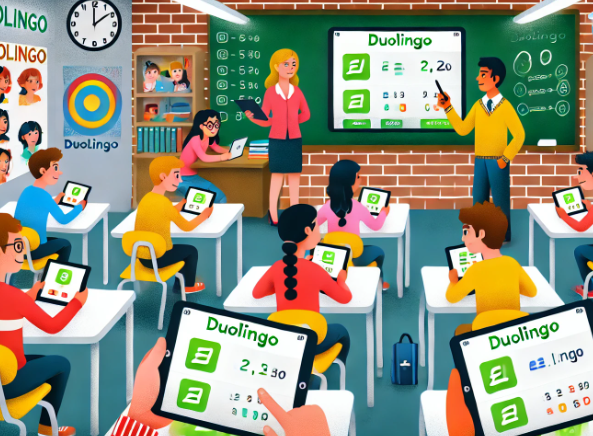Gamified Learning: Evaluating the Impact of Duolingo on Language Retention and Academic Performance in Secondary School Students
DOI:
https://doi.org/10.24903/bej.v6i2.1724Keywords:
Duolingo, Students, Language, AcademicAbstract
The study investigates the relationship between Duolingo usage language learning retention, and academic achievements among high school students. Duolingo, it is known for its user-friendly interface and gamified learning approach, has acquired popularity in the field of language instruction. The major goal of this study is to determine if Duolingo usage improves academic achievement and language retention in secondary school students. This study lasted four months and involved 40 students from SMA Istiqamah Muhammadiyah Samarinda. The collection of data includes Duolingo achievement assessments and questionnaires indicated to assess patterns of Duolingo usage, language retention, and app satisfaction. Statistical analysis, specifically the Pearson correlation coefficient, was employed to assess the level and course of the correlation between Duolingo use and language learning results. The findings indicate a significant positive correlation between the use of Duolingo and the retention of language learning, as well as an improvement in academic achievements. The results suggest that integrating Duolingo into the language learning curriculum is beneficial for students, enhancing both their engagement and learning outcomes. Furthermore, the study highlights the need for further research to explore the specific mechanisms through which Duolingo impacts language learning and to expand the findings to larger and more diverse student populations. This research contributes valuable insights for educators and policymakers seeking to incorporate digital learning tools into language education and underscores the potential of Duolingo as an effective supplementary resource for language learning in secondary schools.
References
Bicknell, K., Brust, C., & Settles, B. (2023). How Duolingo's AI learns what you need to learn: The language-learning app tries to emulate a great human tutor. IEEE Spectrum, 60(3),Pp 28-33. https://doi.org/10.1109/MSPEC.2023.10061631
Dean, R. T., & Dunsmuir, W. T. (2016). Dangers and uses of cross-correlation in analyzing time series in perception, performance, movement, and neuroscience: The importance of constructing transfer function autoregressive models. Behavior research methods, 48, 783-802
Frankel, R. J., & Wellen, N. E. (2008). How to design and evaluate research in education. New York: McGraw-Hill
.Indrasari, A., Novita, D., & Megawati, F. (2018). Big Book: Attractive Media for Teaching Vocabulary to Lower Class of Young Learners. Journal of English Educators Society , 141-154 .
Kannan, J., & Munday, P. (2018). New trends in second language learning and teaching through the lens of ICT, networked learning, and artificial intelligence. Círculo de Lingüística Aplicada a la Comunicación. https://doi.org/10.5209/CLAC.62495
Jašková, J. (2014). Duolingo as a new language-learning website and its contribution to e-learning education (Doctoral dissertation, Masaryk University, Faculty of Education).
Mahbub, M. A., Romsi, A., Bulqiyah, S., & Firdaus, I. A. (2020). Infusing a gamification mechanism through Duolingo for English speaking proficiency: perceptions of the Indonesian EFL instructor and students. Konstruktivisme: Jurnal Pendidikan dan Pembelajaran, 12(1), Pp 69-80.
Mahmudah, L. (2015). An analysis of pronunciation exercises in duolingo application and its contribution as English learning media. Unpublished. Retrieved from http://eprints. walisongo. ac. id/5059/1/113411023. pdf.
.Matra, S. D. (2020). Duolingo Applications as Vocabulary Learning Tools. Journal of English Literature, Linguistic, and Education, 46-52.
Min, H. T. (2008). EFL vocabulary acquisition and retention: Reading plus vocabulary enhancement activities and narrow reading. Language Learning, 58(1), 73-115.
Muzid, S., & Munir, M. (2005). Persepsi Mahasiswa dalam Penerapan E-Learning Sebagai (Studi Kasus Pada Universitas Islam Indonesia). In Seminar Nasional Aplikasi Teknologi Informasi 2005 (SNATI 2005) Pp 27-34.
Nushi, M., & Eqbali, M. H. (2017). Duolingo: A Mobile Application to Assist Second Language Learning. Teaching English with Technology, 17(1), Pp 89-98.
Pokrivčáková, S. (2019). Preparing teachers for the application of AI-powered technologies in foreign language education. Journal of Language and Cultural Education, 7(3), 135-153. https://doi.org/10.2478/jolace-2019-0025
Schank, R. C. (1991). Where's the AI? AI Magazine, 12(4), 38-38.
Santoso, S. (2015). Statistik nonparametrik. Jakarta: PT. Elex Media Komputindo.
Sugiyono. (2016). Metode penelitian kuantitatif, kualitatif, dan R&D. Bandung: Alfabeta.

Downloads
Additional Files
Published
How to Cite
Issue
Section
License
Copyright (c) 2024 Herni Sri Wulandari, Abdul Halim

This work is licensed under a Creative Commons Attribution 4.0 International License.
Authors retain copyright and grant the journal right of first publication with the work simultaneously licensed under a Creative Commons Attribution 4.0 International License that allows others to share the work with an acknowledgment of the work's authorship and initial publication in this journal.



